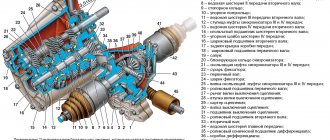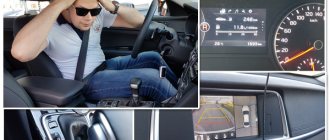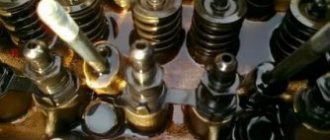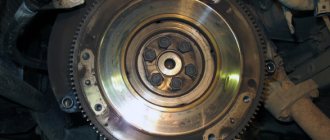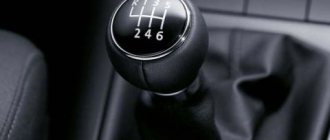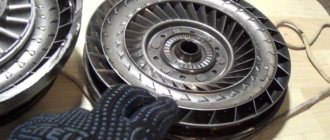The clarity of gear engagement and the operation of the entire shift mechanism often worries owners of cars with a manual transmission. A common problem is that after starting the engine, one or more gears are engaged with great effort or not completely, it is not possible to change gears, at the moment of switching on, extraneous noise is heard, unnecessary vibrations appear, etc.
We also recommend reading the article on how to repair a crack in the cylinder block or cylinder head. In this article, you will learn about various methods for repairing cracked engine block and head.
Such malfunctions appear unexpectedly, and difficulties when shifting gears can increase gradually. Speeds may be difficult to switch on “cold” and/or “hot”. It is noteworthy that gears in a manual transmission often shift normally when the engine is turned off.
Gears are difficult to engage with the engine running: possible reasons
At the very beginning, it should be noted that the inability to engage a gear with the engine not running may indicate a serious gearbox malfunction, which consists of failure of the synchronizers. The second reason may be wear or breakage of the gears. It is also possible that the components and mechanisms responsible for transmitting force from the lever in the cabin to the gearbox when selecting a gear may become jammed.
To accurately determine the causes, in the first case it will be necessary to remove the box for disassembly and subsequent troubleshooting; in the second case, it is necessary to identify and replace broken components. In some cases, it is enough to carry out their prevention: removal, lubrication and careful adjustment.
As for problematic switching when the internal combustion engine is running, then the list of the most common faults includes:
- lack of gear oil in the gearbox;
- problems with the clutch mechanism;
Engine mounting cushion
Oddly enough, this malfunction can significantly affect the quality of the gearbox. Moreover, due to bad airbags, gears are not engaged when the engine is running, both with a manual transmission and an automatic transmission. On some cars, separate supports for the box are installed. Check their integrity and replace if necessary. It is very simple to check - the engine should not jerk from side to side when increasing speed and idling. If the cushions “sag,” the motor will break the linkage or the input shaft will jam.
Low gearbox oil level
An insufficient amount of oil in the box makes the process of shifting gears extremely difficult, but the speeds must be engaged. When switching in this way, a metallic crunch is heard, and when driving in a gear, the transmission begins to make a lot of noise and “howl.”
A complete lack of lubrication in the gearbox will not allow you to change gears, since without oil the synchronizers will not be able to work properly, and the gears in the gearbox will not engage.
Any manifestation of these symptoms requires immediate cessation of operation of the vehicle and checking the transmission oil level in the gearbox. It is also necessary to inspect the gearbox for damage to the housing, oil leaks through the seals and gaskets.
It should be noted that for manual transmissions of many cars, the oil in the gearbox is filled from the factory for the entire service life. In practice, replacement is recommended every 60-80 km. mileage
It is imperative to fill only with lubricant recommended for viscosity and other characteristics. As for adding oil to the transmission, it is necessary to separately take into account the issue of compatibility with the already filled lubricant.
Gearbox linkages and rods
I remember I was “infuriated” on the VAZ 2114 by the fact that the gearbox lever was swinging from side to side like a “spoon in a glass”; I always wanted to make it stiffer, in some way. But there was only one way, to climb down the car and play with the scenes and rods. In principle, they can be released, tightened, the lever can be adjusted for tilt, etc. In general, I played around, but I noticed that if I press the lever too hard to the left, the ability to engage gear (first and reverse) disappears. This manifests itself when the car is not running, I’m already silent about the running engine.
Often the slides break, or they fly out of the fastenings, or the wear is simply enormous and they need to be replaced (this happens with high mileage). The very first thing we do is climb under the car and look at them.
Clutch faults
Simply put, the clutch is a mechanism that serves to transmit the torque of the internal combustion engine to the transmission, and also opens the engine and transmission so that gear can be changed. Failure of individual components of this unit may make it impossible to shift gears while the engine is running.
We also recommend reading the article about devices for starting the engine with a discharged battery. From this article you will learn about the features and selection of boosters (starter chargers).
Brake fluid leaks
The design of many modern cars assumes that the working fluid for the clutch is brake fluid. If there is not enough fluid in the clutch drive hydraulic system, then the clutch will not engage fully.
In this case, the gears will engage slowly or not engage at all. For an initial check, you should look at the fluid level in the reservoir. If the level is low, it is necessary to check for leaks, eliminate defects and bleed the clutch.
If the fluid level is normal and no other reasons have been identified, you will need to remove the gearbox to inspect the clutch elements. Usually, when you try to turn on the speed and this mechanism breaks down, no loud grinding metallic sounds are heard from the gearbox itself.
Release bearing
Gears may not engage or may not engage fully if the fault is related to the clutch basket. The release bearing may also be the cause. If the specified bearing does not move freely along the input shaft or is jammed, then replacement of the part is necessary.
It is necessary to separately add that the primary sign of problems with the release valve is the appearance of a rustling or distinct hum when the car is running. The noise appears only when the clutch pedal is pressed to the floor. Such extraneous sounds can be present both on a cold car and on a warm one. After releasing the clutch pedal, the noise should disappear. A jammed release lever will not allow the clutch to engage, which complicates gear shifting and can also lead to rapid wear and destruction of other elements of the clutch mechanism.
Drive and clutch cables
For rear-wheel drive models (VAZ 2101 - 2107), the gears are engaged hydraulically. That is, when you press the clutch, the fluid pushes the piston, which in turn pushes the clutch fork, which retracts the disc. For front-wheel drive models (VAZ 2108 - 2115), there is no hydraulic connection; everything is done here by mechanics, or rather by the clutch cable, which is connected to the pedals. If your slave cylinder leaks on a rear-wheel drive car or the cable breaks on a front-wheel drive car, the car will not engage in gear. The “fork” simply won’t work. We just check and replace damaged parts.
Clutch basket
Over time, the clutch basket fails on all cars with a manual transmission. Sometimes it’s due to wear and tear, sometimes the petals or the so-called “spider” break. Let me start, perhaps, with the “spider”, this is a mechanically fixed release bearing on several extensions (done like this on some VAZs), if the extension breaks, then it cannot be effectively fixed to the basket - the gears do not engage.
Next, the petals of the box break, or they become weakened. This leads to the fact that it is very difficult, almost impossible, to release the clutch disc. Therefore, the “speeds” do not switch – we just change the basket.
Well, the last wear and tear is the basket disk. It has a metal disk inside, and over time, especially from high mileage, wear forms there. When starting, the car will shake, and if the wear is very large, the gears may not shift.
In any case, we need to change the clutch basket.
Top 10 signs of a faulty gearbox
Mechanical faults in a car, unlike faults in electronics, appear accompanied by extraneous sounds and vibrations, which signal to the average person that something is not working as intended by the designers. Breakdowns in the gearbox are often accompanied by signals that cannot be ignored.
If the gears are switched with effort or are not switched at all, a strange hum and buzzing is heard from the box, or shocks are felt when changing gears, immediately contact a service station for repairs. Driving such a car is, firstly, dangerous, and secondly, you can end up on the highway with a jammed transmission. For serious repairs, the box will have to be removed and opened, so the pleasure is expensive.
After consulting with 13 service station employees, we identified 10 common signs of gearbox failure, tried to explain their cause, and compiled instructions for further action.
TRANSMISSION LEVER REFUSES TO Shift
Since the early 90s, the share of manual transmissions has been declining.
In 2006, in the United States, mechanics could be ordered on 47% of showroom cars. In 2011, there were already 37% of them, and according to the results of the first half of 2021, only about 27%.
If you look at sales, then in 1992 this type of box was chosen by 25% of buyers, in 2012 - 7%, in 2021 - only 3%. In Japan, out of 20 buyers, 19 choose an automatic, and according to experts, this share will only decrease, even in the sports car segment. Read about the disadvantages of manual transmission and the pros versus automatic here.
The excursion into the history of the death of mechanics is over, let's move on to box failures.
Symptom of malfunction: the manual transmission gear shift lever refuses to budge when the clutch pedal is pressed.
This happens when you try to engage first gear after stopping, or any other, up or down when changing gears.
Reason and solutions:
- Low transmission fluid level, incorrect viscosity (thickness) of the fluid. Add or change fluid.
- The shift cables or gear connections need to be adjusted.
THE SMELL OF BURNING IN THE CAR
Symptom of malfunction: If you smell burnt transmission fluid, the car's gearbox is overheated. Transmission fluid lubricates the moving parts of the gearbox and protects itself from self-burning by cooling in the oil receiver or heat exchanger. The oil receiver is installed in the pan of the car, the heat exchanger is located in the radiator area.
Gears do not engage when the engine is running
Stopped shifting gears? What could be the reason
Shifting gears in a manual transmission should be easy and quiet, regardless of whether the engine is running. In general, the engine is connected to the gearbox through a single unit - the clutch. It is with this that the difference in ease of switching is associated. There is one exception to this rule, which will be mentioned later.
Mechanism of interaction between the engine and the gearbox
The torque created by the car engine is removed and transmitted further from the flywheel. The flywheel is usually installed at the rear end of the crankshaft and is securely attached to it with several bolts. The bolts are equipped with special fixing belts in the threaded areas or are installed on an anaerobic retainer. Problems with fastening are extremely rare and are associated with gross mistakes by inattentive or unscrupulous servicemen.
The flywheel is a massive steel part with a machined end surface during manufacturing, along which the front friction lining of the clutch driven disc operates. When the clutch is engaged, the driven disk itself is tightly pressed to the flywheel by a powerful diaphragm spring of the drive disk. The spring, working surface and drive plate housing form the clutch basket. The basket is attached to the flywheel with several bolts around the perimeter of the casing.
The driven clutch disc is located between the flywheel and the drive disc, sometimes called the pressure disc. It consists of two friction linings, respectively to the flywheel and to the pressure plate, a damping device and a splined hub that slides freely along the splines of the gearbox input shaft.
When you press the pedal through a mechanical or hydraulic drive, the release bearing moves along the input shaft of the gearbox. The basket spring compresses and ceases to exert pressure on the driven disk. Zero force on the disc linings will result in zero friction between the flywheel and the linings. The primary shaft of the box, connected by splines to the disk hub, will stop its rotation. In such a situation, engaging a gear in the box is no different from the situation when the engine is not running.
The exception mentioned above is another connection between the engine and the gearbox. The front end of the input shaft rests on a bearing pressed into the end of the crankshaft. The friction in a working bearing is insignificant, and it is not able to spin the shaft when the working clutch is depressed. If rotation is difficult due to bearing wear, the shaft may continue to rotate, and the gearbox synchronizer will have to overcome the resulting parasitic torque with its internal friction. Shifting into gear will be difficult.
Difficulty shifting due to clutch fault
A sign of such a malfunction will be easy engagement of the gear when the engine is off and difficulty when trying to engage first or reverse gear with the car stationary with the engine running. Possible causes may be the following malfunctions.
Transmission problems
Ultimately, any malfunctions in the box lead to difficulties when switching. But this manifests itself already while the car is moving. That is, again with the engine running.
Most often the problem is caused by a faulty synchronizer. This simple device is designed, due to internal friction, to equalize the relative speeds of rotation of gears that engage in mesh. At the same time, due to the same friction, it wears out itself. It all ends with the fact that without grinding and great effort, it will not be possible to drive the gears into engagement. Treatment is to replace the synchronizer assembly. Together with the clutch and gear of a specific transmission.
There may also be problems with the switching mechanisms. For example, with forks. They rub along the annular grooves of the couplings and, despite the special very hard coating, also wear out over time. The transmissions first begin to fail, and then a complete failure occurs.
There are other causes of transmission strikes, but their occurrence can be delayed by the simple procedure of regular oil changes. You should not blindly believe the factory claims that oil is poured there for life. It may be so, but everyone will still want to extend this life. The oil ages and becomes dirty. By the end of its life, the cloudy slurry drained from there can hardly be called oil.
Automatic boxes
As strange as it may sound, theoretically there are no fundamental differences between automatic transmission and manual transmission. Everywhere there are friction pairs (clutches or sets of wet discs), gear transmissions and an oil bath. Therefore, the diseases are the same, as are the measures for repair and prevention. There is no need to allow power slipping during sudden starts, skip oil changes and overheat the mechanisms. It’s just that this is even more relevant for automatic transmissions. The mechanisms here are more delicate, the oil requirements are high, and the cost of repairs is many times higher.
The situation is aggravated by the presence of complex hydraulic automation. Gear shifting here is controlled by a set of valves, which are vitally important to work with clean oil. What a manual transmission can tolerate, an automatic transmission will not tolerate. And instead of a clutch, a torque converter works here, which generates a lot of heat. The properties of the oil deteriorate sharply when heated. The presence of oil radiators does not always help. And to reassemble the box you will need a highly paid specialist with the required qualifications.
Source
Manual transmission bearings
And the last thing that could be the bearings - although they are very strong in the box, sometimes they also “stick”. The box will work like a tractor, especially when warm.
In any case, if you have problems in the gearbox itself, then this is an expensive repair. It is also better to entrust it to professionals, because the gearbox is a very complex mechanism.
As you can see, there are quite a few reasons, but in fairness it is worth noting that mechanical transmissions are a fairly reliable unit; they themselves break down quite rarely, especially if you change the transmission fluid on time and pour a branded one of very good quality.
If the gears do not engage, then these are most likely “attached” problems, starting from the rockers and cables, ending with the basket, clutch disc and flywheel.
Now let’s take a look at a short video version of my article.
And that's ALL for me! I think the information will definitely be useful, read our AUTOBLOG.
( 10 votes, average: 4.70 out of 5)



